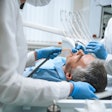
NEW ORLEANS - The recession has hit dentistry more than other businesses, as patients became more cautious about spending on dental services, and insurance companies cut reimbursements, noted Roger Levin, DDS, of practice management firm Levin Group. But he offered several strategies to counter such negative impacts during a well-attended session at ADA 2013.
"The number of new patients is down, so dentists have to do more with each patient," said Dr. Levin, a third-generation dentist who practiced for 10 years in Baltimore before starting his consulting firm in 1985. "They have to make sure their patients have appointments and are coming in. They have to make sure patients value dental services so they don't skip hygiene appointments and then disappear from the practice."
“The number of new patients is down, so dentists have to do more with each patient.”
The recession kept many patients from coming in for preventive care, he noted. And, unlike most medical care, dental insurance has co-payments. He cited some sobering statistics: Five years ago, 91% of dental practices were growing, but during the last few years 75% of practices have experienced declines in production.
The economy is growing again, Dr. Levin noted, but dentistry is not coming back as strongly. Consumers have become savers instead of spenders and are cautious about their spending.
Also, the number of dentists was low, and the demand for oral care was high. Now, with 15 new dental schools slated to open, there will be more dentists to compete with.
And insurance companies are cutting reimbursements: Delta Dental of Washington has cut reimbursement rates by 15%; Ohio insurers cut rates by 7%, and New Jersey dentists saw 5% cuts. Most insurance plans will switch to preferred provider organization (PPO) plans, Dr. Levin predicted, which pay lower reimbursements.
Another factor facing solo practitioners is the huge growth in dental service organizations (DSOs). Five years ago, only 4% of dentists worked for DSOs; now, nearly 18% of dentists are affiliated with them, he noted.
Also, students are graduating saddled with higher school loans, ranging from an average of $277,000 to $400,000 from for-profit schools. Dr. Levin recalled a 55-year-old dentist who's still paying his student loan.
The average dentist is now working eight to 10 years longer, resulting in fewer available associateships for newly minted dentists. The average age of retirement for dentists will be 74, he predicted.
Are more referrals the answer?
One of the biggest things practices can do to increase productivity is getting patients to refer more of their families and friends, Dr. Levin said.
"Referrals can no longer be a 'we hope we get them' process," he noted, adding that practices should aim at getting 40% to 60% of their patients to refer others annually. "You have to give them incentive to refer other patients."
More can be done with first visits by introducing patients to staffers and developing some level of relationship, Dr. Levin advised.
Practices should aim to get 98% of their active patients scheduled for their next appointment. Dr. Levin also stressed the value of scripting all conversations with patients, especially for such things as emergency visits and when discussing financial payment options with patients.
Patient satisfaction surveys also are a an important way to gauge and maintain the relationship, he said.
Some 75% of practice revenue comes from dentists, and 25% from hygiene treatments, he said. "Hygiene is a huge profit factor," Dr. Levin said.
While most general practices and specialists have suffered declines in business during the last few years, pediatric dentists are flourishing, he noted.
Parents want their children treated by a specialist, he explained, and there are only about 4,000 pediatric specialists. And more children on Medicaid are going to the dentist, especially with the mandate for pediatric coverage under the Patient Protection and Affordable Care Act (ACA).
Dr. Levin expects more children to come in for dental care under ACA, but he said most dentists don't take Medicaid or know how to handle low-reimbursement patients. Healthcare reform will have little effect on the adult population, because most states don't offer Medicaid dental coverage for adults, and reimbursements are so low dentists can't cover overhead costs, he said.
"I don't think a lot of adults will come in," Dr. Levin said. "Mainly, it will affect children and those in underprivileged programs."


















